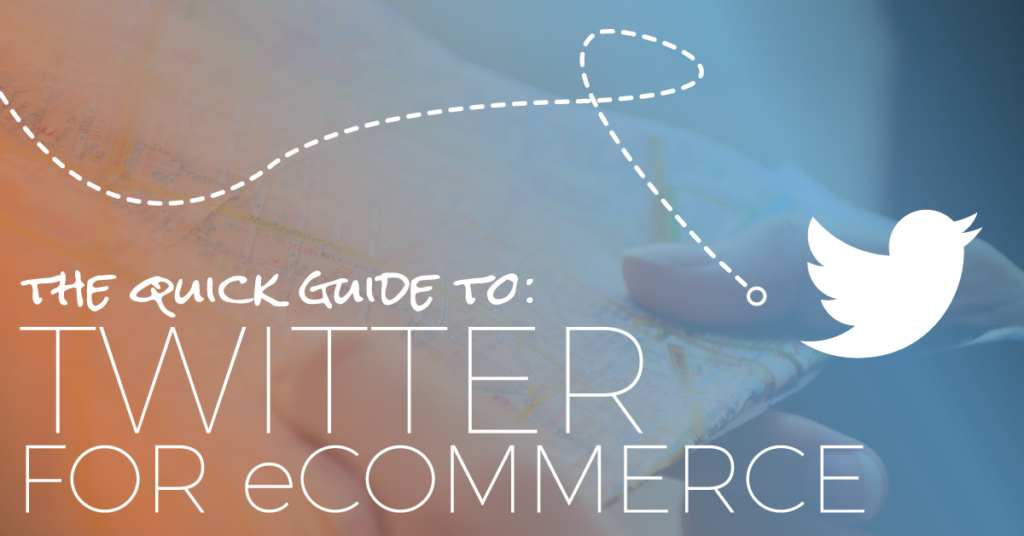Despite the ever-increasing popularity of new social media and communication apps like Snapchat, Vine, Messenger, and others, Twitter remains one of the most effective tools that business owners can use to build brand awareness, engage with current and future customers, sell products, and grow their businesses.
An active and intentional brand presence on Twitter can have a significant impact on the purchasing behaviors of online shoppers. A 2015 study performed by Millward Brown and Twitter reported the following:
“Whether they’re learning about a new product or on the brink of buying, shoppers rely on Twitter for information and advice. Our survey with Millward Brown showed that nearly half (49%) of female Twitter shoppers say Twitter content has influenced their purchase decisions, which makes the platform prime real estate for brands. These shoppers on Twitter are also engaged: they’re 160% more likely to stay up-to-date on brand news and promotions, 120% more likely to search for deals and sales and 240% more likely to converse with a brand than retail shoppers on the average social network.”
As the owner of an ecommerce business, you can’t afford to ignore Twitter. It’s one of the easiest and most effective ways to connect and engage with an audience of people who are already using the internet on a regular basis to communicate with friends, find solutions to their problems, research companies, and buy products.
This guide will provide you with the information, best practices, and tools you need to understand how to best leverage Twitter to grow your ecommerce business.
The Numbers
Before diving too deep into the strategies, best practices, and tools you can use to get more ROI from Twitter, it’s important to understand the numbers. Here are the most important statistics worth knowing about:
- As of 2015, there were around 1.3 billion registered users on the platform.
- As of today, there are around 310 million monthly active users on the site.
- As of today, 83% of those active users are accessing from mobile devices.
- As of 2015, 23% of all online adults use Twitter, and 38% of those who use it do so on a daily basis.
- As of 2015, 32% of people between the ages of 18-29 use Twitter, compared to 29% between the ages of 30-49, and 19% over the age of 50.
- As of 2015, according to the Pew Research Center, 25% of male internet users use Twitter and 21% of female internet users use Twitter.
- For more demographic research, explore the entire report from the Pew Research Center titled The Demographics of Social Media Users. There’s also a helpful infographic worth checking out that Sprout Social published in May 2015 that illustrates the demographics of Twitter and other popular social media sites.
The Purpose
Now that you’ve got some background on the audience you could potentially be tapping into by participating on Twitter, it’s helpful to understand its purpose for ecommerce. Before you can justify allocating whatever amount of time, energy, and money you ultimately decide to put into Twitter, you need to first understand the potential value it can bring to your business. Here are five reasons why most ecommerce businesses use Twitter:
Reason #1. To Boost Brand Exposure – If your ecommerce business is fairly new, Twitter is a great way to create initial buzz around your brand and products. As soon as you launch your website and shop, it’s important that you make an effort to start participating organically on social media sites as soon as possible. Doing so will help you begin to build up your reputation and connect with your first potential customers. You can boost brand exposure early on by answering questions, sharing your brand story, posting photos and videos of your products, and interacting authentically with ideal customers.
Reason #2. To Be Part of the Conversation – Your potential customers aren’t just learning about you by going to your website alone anymore—they’re also turning to social media sites like Twitter to find out what their friends and people they’ve never met or interacted with think about you. Twitter gives you the opportunity to monitor and authentically engage in conversations that people are having about you and your business.
Reason #3. To Share Value & Drive More Traffic – Consumers today aren’t always using the internet to search for specific brands and products—instead, they’re using it to find answers to their questions and solutions to their problems. In order to ensure that your ideal customer is finding and interacting with your business and not your competitors, you need to leverage yourself as a helpful resource that they can find and access when they need help. Twitter provides you with a platform to share value and gives you the opportunity to direct potential customers to your website to find the answers and solutions they’re looking for.
Reason #4. To Advertise & Sell Products – Twitter is a powerful tool for advertising and selling products. As an ecommerce business, you can easily build and launch a variety of paid campaigns that ultimately help you achieve different goals—whether you want more website visitors, more social engagement, more exposure, more leads, or more sales. There’s no minimum spend, and you can start and stop campaigns at any time. You can even set up “Buy Now” campaigns that allow users to buy individual products directly on Twitter. For more information on how to do this for your ecommerce business, explore this page from Twitter.
Reason #5. To Provide Support – Twitter has become a standard tool for businesses to use to interact with customers and provide support. It’s important to understand that once you decide to create a presence for your brand on social media sites like Twitter and Facebook, you’re opening the door for people to have direct conversations with you—whether they’re good or bad. It’s a two-way form of communication: you can send messages out to people, and they can send messages back. As an ecommerce business, you can either choose to ignore the messages you get from unhappy customers on Twitter who need your help, or you can address them publicly and use each interaction as an opportunity to show people that you care about serving the needs of your customers and that you’re available when people need help. If you’re interested in learning more about how to start using Twitter as a customer service tool for your ecommerce business, explore this 100+ page free guide from Twitter. It’ll give you everything you need to get started.
The Best Practices
If you haven’t spent much time using Twitter as a business before, there are a few best practices you should be aware of before getting started. Here are 10 tips to help you get the most out of Twitter as an ecommerce business:
Tip #1: Be consistent. As mentioned earlier, the only way you’ll ever be able to get any sort of ROI from Twitter is by being consistent about when and how often you publish updates and engage with followers.
Tip #2: Be genuine. Twitter is about conversations. When interacting with followers and customers, try to have authentic, meaningful conversations. Don’t make people feel like they’re talking to your lawyer. Show people that there are actually caring people running your business.
Tip #3: Understand your audience. Know who you’re trying to reach on Twitter. There are a lot of resources out there that can help you understand when and how to best interact with your audience (check out this one from Buffer). Leverage them whenever possible in order to boost your success.
Tip #4: Add value. Always go out of your way to help the people you interact with on Twitter, even if they don’t end up becoming a customer. Twitter isn’t about sharing promotional coupons, it’s about sharing content that other people might find useful. Think about how you can share more value with your followers through the tweets you publish and the content you share.
Tip #5: Be responsive. Twitter users expect prompt responses when they reach out to brand and businesses. Make sure you’re using tools that allow you to monitor and respond to messages directed at your brand in real-time. ProTip: you should also make sure the Direct Messaging feature is turned on for your account. This will allow you to provide even better customer service to the people who reach out to you for help.
Tip #6: Leverage data and analytics. Use Google Analytics, Buzzsumo, and Twitter Analytics to improve your paid campaigns, boost engagement with followers, understand your audience better, and drive more traffic to your website.
Tip #7: Don’t be too promotional. You’re going to want to share information about your products and company on Twitter, and that’s fine, just don’t overdo it. Twitter users want authentic, real interactions with brands—they don’t want to feel like you’re shoving your products down their throats every time they see your tweets.
Tip #8: Test, test, test. To get the most out of Twitter for ecommerce, you have to be willing to test new campaign ideas, new strategies, new types of content, new publishing times, and anything else you can think of that might boost your success. To get started with testing, check out this resource from Hootsuite and this resource from Buffer.
The Tools
There are a number of tools you can use to boost productivity and success on Twitter as an ecommerce business. Here are 9 worth checking out:
- Buy Now from Twitter – for selling your products on Twitter
- Mention – for tracking and responding to mentions of your brand
- Buzzsumo – for curating content and connecting with the right followers
- Buffer – for scheduling your updates ahead of time
- Canva – for easily creating compelling images to share with your followers
- Twitter Cards – for driving more engagement from your tweets
- Narrow – for building the right following
- Crowdfire – for growing your following
- Google Analytics – for testing and learning more about your audience
For even more Twitter tools, check out this list from Buffer.
What has your experience been using Twitter for ecommerce? Share your experience below.


